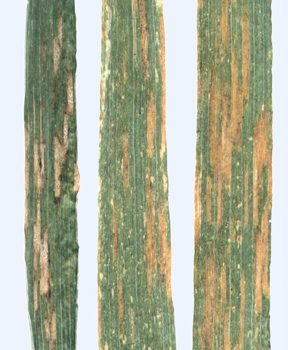Diseases
Mycosphaerella graminicola (Fuckel) J. Schroet. - Septoria Leaf Blotch of Wheat = Septoria tritici Blotch = Speckled Leaf Blotch
Systematic position.
Ascomycota, oder Dothideales, family Mycosphaerellaceae, species M. graminicola. Anamorph Septoria tritici Roberge ex Desm.Biological group.
Hemibiotrophic wheat pathogen.Morphology and biology.
S. tritici infects mainly leaves and more seldom the sheaths and stems during the whole vegetation period; lesions linear, bright-brown to brown in color, bleaching in centers as the lesions develop. The disease lesions on both leaf surfaces are linear, yellow-brown, rubiginous, or green -brown, sometimes with light center, without or with yellow or dark-reddish bordering, 5-10x2-5 mm in size, sometimes merged. Small, spherical, dark brown in color pycnidia are formed in the center of spots. Fungi survives on infected plant refuses or seedlings as pycnidia and mycelium. Ascomata (pseudothecia) are formed on overwintered wheat leaves. Conidia and ascospores serve as primary infection for inoculation of wheat seedlings. Pycnidia are light-brown, brown, or yellow, spherical, semisubmerged, 75-270 mkm in diameter; stoma is spherical, 30-40x15z18 mkm in diameter. Conidia are filamentous, straight or bent, hyaline or greenish, ends of them are radiused or blunt-radiused, with 3 to 4, more seldom with 5 to 7 septa, 36-98x2-5 mkm in size. Ascoma is 100 mkm in diameter, with short conic stoma. Asci are cylindrically club-shaped, on short neck, 24-28x8-9 mkm in size. Ascospores are bicellular, ovoid, oval-fusiform, straightened or curved, 9-11x1.5-2.5 mkm in size.Distribution.
S. tritici has wide distribution in the Russian Federation, but it dominates and causes harmfulness in south regions mainly, i.e., in the North Caucasus, Lower Volga Basin, Central Black Earth Region, in the south of Ukraine and Moldova. In the Central Black Earth Region and North Caucasus frequency of epiphytoties is 4 to 5 years for decade, and yield losses may reach to 30%. In central regions of Non-Black Earth areas and Byelorussia S. tritici and S. nodorum occurs in approximately equal ratio. Epithytoty is registered 4 years for decade, yield losses reach to 30%.Ecology.
Conidia are spread by rain or wind blows. Conidia germinate under temperature 9 to 28.C (optimum 20 to 22.C); leaf wetness is required. Incubation period of the disease lasts from 6 to 9 days. Pathogen develops in several generations during a vegetation season. The frequent rainy periods are favorable for rapid spread of the Septoria Leaf Blotch.Economic significance.
The pathogen occurs on wheat, barley, rye, oat and wilds cereals. The disease is widely distributed and harmful. In diseased plants assimilative surface of leaves decreases, and spikes remain undeveloped. Yield losses under moderate disease development reach 10 to 15%, and under ephiphtoty, 30 to 50%. Protection measures include optimal sowing time, balanced application of fertilizing, spraying by fungicides during wheat vegetation, cultivation of resistant varieties.Related references:
Borzionova T.I., Vasetskaya M.N. Special feature of septoria disease in conditions of forest steppe and submontane Altai districts // Sibirskii vestnik s.-h. nauki.- 1991, N1. - P. 43-46 (in Russian).Hawksworth D.L., Kirk P.M., Sutton B.C., Pegler D.N. 1995. Dictionary of the fungi. - CAB International Institute Kew: Surrey. - 663 pp.
Ishkova T.I., Berestetskaya L.I., Gasich E.V., Vlasov D.Y. 2001. Methodical instruction for diagnostics of major cereal fungal diseases. - St.Petersburg: VIZR. - 76 pp. (in Russian).
Koishibaev M., Ismailov E.T. 1991. Feature of development and harmfulness of Septoria diseases of wheat in Kazakhstan // Bulletin s.-kh. nauk Kazakhstan.- N11.-P.31-36 (in Russian).
Rudakov O.V, Titova K.D., Pospekhov G.V., Fissura N.I. 1989. Zones of harmfulness of leaf spot blotches pathogens //Povyshenie produktivnosti i ustoichivosti proizvodstva zerna ozimoi pshenitsy v SSSR /Sbornik nauchnykh trudov. - Mironovka. - P.134-139. (in Russian).
Sanin S.A. 2000. To increase the level of phytosanitary safety of the country // Zashchita rastenii i karantin . - N12. - P. 3-7. (in Russian).
Sanina A.A., Antsiferova L.V. 1991. Species composition of spp. Septoria Sacc. on wheat in the European part of the USSR // Micologiya i fitopatologiya. - V. 25 (3).- P. 250-252 (in Russian).
Sanin S.S., Nazarova L.N., Sokolova E.A., Ibragimov T.S. 1999. Health of cereal fields. Zashchita i karantin rastenii. - N2. - P. 28-31. (in Russian).
Vasetskaya M.N. 1989. Actuality and perspectives of wheat septoriosis studies in the USSR // Povyshenie produktivnosti i ustoichivosti proizvodstva zerna ozimoi pshenitsy v SSSR /Sbornik nauchnykh trudov. - Mironovka. - P. 115-129 (in Russian).
Zakharenko V.A., Kuzmichev A.A., Plotnikov V.F., et al. 2000. Extent and trends of species composition and population structure changes, areas of harmful and useful organisms complexes, and forecast of dangerous phytosanitary situations in Russian regions. St. Petersburg: RASKhN. - P. 1-100 (in Russian).
Zakharenko V.A., Ovsyankina A.V., Sanin S.S., etc. 2003. Maps of distribution of harmful organisms, pathotypes, disease virulence genes, phytophages, entomopathogens in territory of Russian Federetion.-Moscow: Rosselkhozakademia. - 64 pp. (in Russian).


